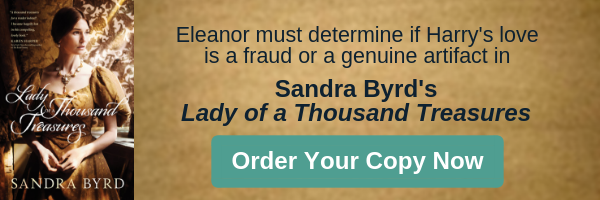In Lady of a Thousand Treasures by Sandra Byrd, Lady Eleanor Sheffield evaluates antiquities. Discover interesting facts about antiques from the Victorian era in the piece below by author Sandra Byrd.
I love to travel to many places, but I also love to travel to many times, eras out of reach for a visit except through literature and film. I choose to write historical novels because, through them, we can time-and-place travel together, you and me.
Journeying through books has limitations, though. To do so, we must use our imaginations, but we are sensory by nature, and that is why I think objects from the past—treasures, as Ellie, my heroine in Lady of a Thousand Treasures, understands—have such a pull on us. We touch something that a real person, with hopes and dreams much like our own, touched dozens or hundreds of years earlier, and suddenly the centuries between us disappear.
I have a friend—let’s call her my friend of a thousand treasures—who works as an antiquarian, and she owns many such treasures. She is willing to share some of her trove with me, allowing me to share some of her prizes with you.
In the ages before smallpox was scoured from the earth, women sought—as they do now—to minimize their scars and blemishes with cosmetics. One tool was the use of beauty marks, small rounds (or sometimes hearts) of black fabric affixed to the face with glue or honey, covering an unsightly spot in a flirtatious manner. After the patches were removed at the woman’s toilette, she would save them in lovely porcelain patch boxes.

Although it’s fun to handle and hold something once owned by a commoner such as myself, it’s even more awe-inspiring to hold something that might have been touched by royalty and was certainly used by the nobility. This plate, created by Minton, was part of an extensive set that graced the table of Queen Victoria.

Who held it? Whose meal was presented upon it? What would have happened to a scullery girl if she’d dropped it? If I close my eyes when I hold this plate, I can imagine myself both eating at the beeswax candlelit table and washing the plate below stairs by tallow candlelight.
One interesting fact about the Minton company is not as well known. It was rumored that Prince Albert himself was secretly among those who helped design their tiles. Perhaps that is one reason Her Majesty chose their wares to grace her table.
Although in modern times acquiring fragrant spices is as easy as reaching for a container on the grocery store shelf, it was not always that way. When England, via their East India Company, began transporting spices from east to west, those spices were dear, indeed. As such, they became not only a way to flavor food and drink, but a status symbol of sorts. Men would carry a portable nutmeg grater with them, and after acquiring a cup of punch for themselves or their dance partner, they grated some of the aromatic powder atop the filled glass, where it floated as a symbol of wealth and affection.

I hope you’ve enjoyed these historical tidbits. If so, please journey with me to Victorian England and the many treasures to be found in my new novel, Lady of a Thousand Treasures.
Lady of a Thousand Treasures by Sandra Byrd
Miss Eleanor Sheffield is a talented evaluator of antiquities, trained to know the difference between a genuine artifact and a fraud. But with her father’s passing and her uncle’s decline into dementia, the family business is at risk. In the Victorian era, unmarried Eleanor cannot run Sheffield Brothers alone.
The death of a longtime client, Baron Lydney, offers an unexpected complication when Eleanor is appointed the temporary trustee of the baron’s legendary collection. She must choose whether to donate the priceless treasures to a museum or allow them to pass to the baron’s only living son, Harry—the man who broke Eleanor’s heart.


